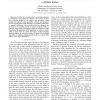Free Online Productivity Tools
i2Speak
i2Symbol
i2OCR
iTex2Img
iWeb2Print
iWeb2Shot
i2Type
iPdf2Split
iPdf2Merge
i2Bopomofo
i2Arabic
i2Style
i2Image
i2PDF
iLatex2Rtf
Sci2ools
ICRA
2008
IEEE
2008
IEEE
Maximum likelihood estimation of sensor and action model functions on a mobile robot
— In order for a mobile robot to accurately interpret its sensations and predict the effects of its actions, it must have accurate models of its sensors and actuators. These models are typically tuned manually, a brittle and laborious process. Autonomous model learning is a promising alternative to manual calibration, but previous work has assumed the presence of an accurate action or sensor model in order to train the other model. This paper presents an adaptation of the Expectation-Maximization (EM) algorithm to enable a mobile robot to learn both its action and sensor model functions, starting without an accurate version of either. The resulting algorithm is validated experimentally both on a Sony Aibo ERS-7 robot and in simulation.
Accurate | ICRA 2008 | Mobile Robot | Robotics | Sensor Model |
Related Content
| Added | 30 May 2010 |
| Updated | 30 May 2010 |
| Type | Conference |
| Year | 2008 |
| Where | ICRA |
| Authors | Daniel Stronger, Peter Stone |
Comments (0)

